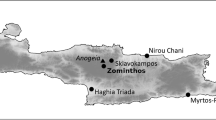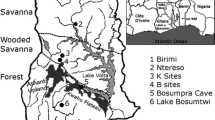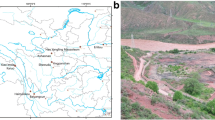Abstract
With the advent of sedentism, or living in permanent settlements, a new way of life began. The hunter and gatherers’ well established subsistence strategy of thousands of years slowly moved towards farming, beginning with herding and cultivation and leading to the domestication of animals and plants. The Aceramic Neolithic site of Körtik Tepe in southeastern Anatolia, Turkey, provides insight into a permanent settlement of hunters and gatherers at the end of the Pleistocene and the beginning of the Early Holocene. Archaeobotanical investigations at the site including charcoal studies provide new information about the origins of agriculture in the northern Fertile Crescent. With the start of the Younger Dryas, there was an opening up of the oak woodland, which may have allowed widespread dense stands of annual, especially small-seeded grasses and riverine taxa to grow and thus provide staple foods for the inhabitants of Körtik Tepe. With the beginning of the Early Holocene, the oak woodland spread again and replaced these open grass-dominated stands, and the people of Körtik Tepe seem to have then favoured large-seeded grasses, nuts and legumes. Riverine taxa and a large diversity of edible plants were used for subsistence in both time periods. Increasing numbers of chaff remains and weeds in the Early Holocene samples suggest small-scale cultivation of the wild progenitors of cereals and pulses.






Similar content being viewed by others
References
Abbo S, Gopher A, Rubin B, Lev-Yadun S (2005) On the origin of Near Eastern founder crops and the “dump-heap hypothesis”. Genetic Res Crop Evol 52:491–495
Abbo S, Gopher A, Peleg Z, Saranga Y, Fahima T, Salamini F, Lev-Yadun S (2006) The ripples of “The Big (agricultural) Bang”: the spread of early wheat cultivation. Genome 49:861–863
Abbo S, Lev-Yadun S, Gopher A (2010) Agricultural origins: centers and noncenters; a Near Eastern reappraisal. Crit Rev Plant Sci 29:317–328
Arbuckle BS, Özkaya V (2006) Animal exploitation at Körtik Tepe: an early Aceramic Neolithic site in southeastern Turkey. Paléorient 32:113–136
Asouti E, Fairbairn AS (2010) Farmers, gatherers or horticulturalists? Reconstructing landscapes of practice in the early Neolithic. In: Finlayson B, Warren G (eds) Landscapes in transition. Oxbow Books, Oxford, pp 161–172
Asouti E, Kabukcu C (2014) Holocene semi-arid woodlands in the Irano-Anatolian region of Southwest Asia: natural or anthropogenic? Quat Sci Rev 90:158–182
Baruch U, Bottema S (1999) A new pollen diagram from Lake Hula. Vegetational, climatic and anthropogenic implications. In: Kawanabe H, Coulter GW, Roosevelt AC (eds) Ancient lakes. Their cultural and biological diversity. Kenobi Productions, Gent, pp 75–86
Bar-Yosef O (2011) Climatic fluctuations and early farming in west and east Asia. Curr Anthropol 52(S4):175–193
Bar-Yosef O, Belfer-Cohen A (1989) The origins of sedentism and farming communities in the Levant. J World Prehist 3/4:447–498
Bar-Yosef O, Belfer-Cohen A (1999 [2002]) Facing environmental crisis - societal and cultural changes at the transition from the Younger Dryas to the Holocene in the Levant. In: Cappers RTJ, Bottema S (eds) The dawn of farming in the Near East. (Studies in Early Near Eastern Production, Subsistence and Environment 6). Ex Oriente, Berlin, pp 55–66
Bar-Yosef O, Meadow RH (1995) The origins of agriculture in the Near East. In: Price TD, Gebauer AB (eds) Last hunters—first farmers: new perspectives on the prehistoric transition to agriculture. School of American Research Press, Santa Fe, pp 39–94
Benz M (2014) Stratigraphies. http://www.vorderasien.uni-freiburg.de/forschung/projekte-der-mitarbeiterinnen/dr.-marion-benz/koertik-tepe/ktk2012strati. Accessed 12 Jan 2017
Benz M, Coşkun A, Hajdas I, Deckers K, Riehl S, Alt KW, Weninger B, Özkaya V (2012a) Methodological implications of new radiocarbon dates from the early Holocene site of Körtik Tepe, Southeast Turkey. Radiocarbon 54:291–304
Benz M, Coşkun A, Rössner C, Deckers K, Riehl S, Alt KW, Özkaya V (2012b) First evidence of an Epipalaeolithic hunter-fisher-gatherer settlement at Körtik Tepe. Neo-Lithics 1/12:25–32
Benz M, Deckers K, Rössner C et al (2015) Prelude to village life. Environmental data and building traditions of the Epipalaeolithic settlement at Körtik Tepe, southeast Turkey. Paléorient 41:9–30
Benz M, Erdal YS, Şahin FS, Özkaya V, Alt KW (2016) The equality of inequality. Social Differentiation among the hunter-fisher-gatherer community of Körtik Tepe, southeastern Turkey. In: Meller H, Hahn HP, Jung R, Risch R (eds) Rich and poor—competing for resources in prehistory. (Tagungen des Landesmuseums für Vorgeschichte Halle 13) Landesamt für Denkmalpflege und Archäologie. Sachsen Anhalt–Landesmuseum für Vorgeschichte Halle (Saale), Halle, pp 147–164
Binford S, Binford L (1968) New perspectives in archaeology. Aldine Publishing Company, Chicago
Bottema S (2007) Late Pleistocene and Holocene vegetation at Zeribar. In: Wasylikowa K, Witkowski A (eds) The palaeoecology of Lake Zeribar and surrounding areas, western Iran, during the last 48,000 years. (Diatom Monographs 8). ARG Gantner, Rugell, pp 53–104
Braidwood RJ, Howe B (1960) Prehistoric investigations in Iraqi Kurdistan. (Studies in Ancient Oriental Civilization 31). The University of Chicago Press, Chicago
Byrd BF (2005) Reassessing the emergence of village life in the Near East. J Archaeol Res 13:231–290
Cappers RTJ, Woldring H, Van der Plicht H, Streurman HJ (2002) Modelling the emergence of farming: implications of the vegetation development in the Near East during the Pleistocene-Holocene transition. In: Bottema S, Cappers RTJ (eds) The dawn of farming in the Near East. (Studies in Early Near Eastern Production, Subsistence and Environment 6). Ex Oriente, Berlin, pp 3–14
Childe GV (1941) Man makes himself. Watts, London
Cohen MN (1977) Food crisis in prehistory: overpopulation and the origins of agriculture. Yale University Press, New Haven
Colledge S (2001) Plant exploitation on Epipalaeolithic and Early Neolithic sites in the Levant. BAR Int Ser 986. John and Erica Hedges Ltd, Oxford
Colledge S, Conolly J (2010) Reassessing the evidence for the cultivation of wild crops during the Younger Dryas at Tell Abu Hureyra, Syria. Environ Archaeol 15:124–138
Colledge S, Conolly J, Shennan S (2004) Archaeobotanical evidence for the spread of farming in the eastern Mediterranean. Curr Anthropol 45(S4):35–58
Davis PH, Cullen J, Coode JE (1988) Flora of Turkey and the East Aegean islands, vol 10. Edinburgh University Press, Edinburgh
Deckers K (2016) Oak charcoal from northeastern Syria as proxy for vegetation, land use and climate in the second half of the Holocene. Rev Palaeobot Palynol 230:22–36
Dufraisse A (2008) Firewood management and woodland exploitation during the late Neolithic at Lac de Chalain (Jura, France). Veget Hist Archaeobot 17:199–210
Ferrio JP, Arab G, Buxo R, Guerrero E, Molist M, Voltas J, Araus JL (2012) Agricultural expansion and settlement economy in Tell Halula (Mid-Euphrates valley): A diachronic study from early Neolithic to present. J Arid Environ 86:104–112
Flannery KV (1969) Origins and ecological effects of early domestication in Iran and the Near East. In: Ucko PJ, Dimbleby GW (eds) The domestication and exploitation of plants and animals. Duckworth, London, pp 73–100
Flannery KV (1973) The origins of agriculture. Annu Rev Anthropol 2:271–310
Fuller DQ, Willcox G, Allaby RG (2012) Early agricultural pathways: moving outside the ‘core area’ hypothesis in southwest Asia. J Exp Bot 63:617–633
Gopher A, Abbo S, Lev-Yadun S (2001) The “when,” the “where” and the “why” of the Neolithic revolution in the Levant. Doc Prehist 28:49–62
Harlan JR (1992) Crops and man, 2nd edn. American Society of Agronomy, Madison
Harlan JR (1995) Agricultural origins and crop domestication in the Mediterranean region. Diversity 11:14–16
Hart TC (2014) Phytoliths, starch grains, and emerging social complexity at Tell Zeidan, Syria. Dissertation, University of Connecticut 395. http://digitalcommons.uconn.edu/dissertations/395. Accessed 22 Nov 2016
Henry DO (1989) From foraging to agriculture: The Levant at the end of the Ice Age. University of Pennsylvania Press, Philadelphia
Hillman GC (1996) Late Pleistocene changes in wild plant-foods available to hunter-gatherers of the northern Fertile Crescent: possible preludes to cereal cultivation. In: Harris DR (ed) The origins and spread of agriculture and pastoralism in Eurasia. UCL, London, pp 159–203
Hillman GC (2001) New evidence of Lateglacial cereal cultivation at Abu Hureyra on the Euphrates. Holocene 11:383–393
Hillman GC, Colledge SM, Harris DR (1989) Plant-food economy during the Epipalaeolithic period at Tell Abu Hureyra, Syria: dietary diversity, seasonality, and modes of exploitation. In: Harris DR, Hillman GC (eds) Foraging and farming: the evolution of plant exploitation. (One World Archaeology 13). Routledge, London, pp 240–268
Hole F (1984) A reassessment of the Neolithic revolution. Paléorient 10:49–60
Hole F (1998) The spread of agriculture to the eastern arc of the Fertile Crescent: Food for the herders. In: Damania AB, Valkoun J, Willcox G, Quallset CO (eds) The origins of agriculture and crop domestication. International Center for Agricultural Research in Dry Areas, Aleppo, pp 83–92
Ibáñez JJ, Anderson PC, González-Urquijo J, Gibaja J (2016) Cereal cultivation and domestication as shown by microtexture analysis of sickle gloss through confocal microscopy. J Archaeol Sci 73:62–81
Kenyon KM (1979) Archaeology in the holy land, 4th edn. WW Norton and Co, New York
Klimadiagramme (2016) Diyarbakir. http://www.klimadiagramme.de/Europa/diyarbakir.html. Accessed 6 Nov 2016
Kozlowski SK (1990) Nemrik 9, a PPN Neolithic site in Northern Iraq. Paléorient 15:25–31
Lev-Yadun S, Gopher A, Abbo S (2000) The cradle of agriculture. Science 288:1,602–1,603
Litt T, Krastel S, Sturm M, Kipfer R, Örcen S, Heumann G, Franz SO, Ülgen UB, Niessen F (2009) Lake Van Drilling Project ‘PALEOVAN’, International Continental Scientific Drilling Program (ICDP): results of a recent pre-site survey and perspectives. Quat Sci Rev 28:1,555–1,567
Maher LA, Richter T, Stock JT (2012) The pre-Natufian Epipaleolithic: long-term behavioral trends in the Levant. Evol Anthropol 21:69–81
McCorriston J, Hole F (1991) The ecology of seasonal stress and the origins of agriculture in the Near East. Am Anthropol 93:46–69
Meadows J (2005) The Younger Dryas episode and the radiocarbon chronologies of the Lake Huleh and Ghab valley pollen diagrams, Israel and Syria. Holocene 15:631–636
Miller NF (1999) Seeds, charcoal and archaeological context: interpreting ancient environment and patterns of land use. TÜBA-AR 2:15–27
Moore AMT, Hillman GC, Legge AJ (2000) Village on the Euphrates: from foraging to farming at Abu Hureyra. Oxford University Press, New York
Neef R (2003) Overlooking the steppe-forest: A preliminary report on the botanical remains from early Neolithic Göbekli Tepe (southeastern Turkey). Neo-Lithics 2/16:13–15
Niklewski J, Van Zeist W (1970) A late Quaternary pollen diagram from northwestern Syria. Acta Bot Neerl 19:737–754
Özkaya V (2009) Excavations at Körtik Tepe. A new Pre-Pottery Neolithic A site in southeastern Anatolia. Neo-Lithics 2/09:3–8
Özkaya V, Coşkun A (2011) Körtik Tepe. In: Özdoğan M, Başgelen N, Kuniholm P (eds) The Neolithic in Turkey, vol 1. Archaeology and Art Publications, Istanbul, pp 89–127
Peasnall BL (2000) The round house horizon along the Taurus-Zagros arc: a synthesis of recent excavations of late Epipaleolithic and early Aceramic Sites in southeastern Anatolia and northern Iraq (January 1, 2000). Dissertation, available from ProQuest. http://repository.upenn.edu/dissertations/AAI9965539. Accessed 27 Oct 2016
Portillo M, Llergo Y, Ferrer A, Albert RM (2017) Tracing microfossil residues of cereal processing in the archaeobotanical record: an experimental approach. Veget Hist Archaeobot 26:59–74
Riehl S, Zeidi M, Conard NJ (2013) Emergence of agriculture in the foothills of the Zagros Mountains of Iran. Science 341:65–67
Roberts N (2002) Did prehistoric landscape management retard the postglacial spread of woodlands in south-west Asia? Antiquity 76:1,002–1,010
Rosenberg M, Nesbitt M, Redding RW, Strasser TF (1995) Hallan Çemi Tepesi: Some preliminary observations concerning early Neolithic subsistence behaviors in eastern Anatolia. Anatolica 21:3–12
Savard M (2004) Epipalaeolithic to early Neolithic subsistence strategies in the northern Fertile Crescent. The archaeobotanical remains from Hallan Çemi, Demirköy, M’lefaat and Qermez Dere. Doctoral thesis, University of Cambridge
Savard M, Nesbitt M, Jones MK (2006) The role of wild grasses in subsistence and sedentism: new evidence from the northern Fertile Crescent. World Archaeol 38:179–196
Schreiber F, Coşkun A, Benz M, Alt KW, Özkaya V (2014) Multilayer floors in the early Holocene houses at Körtik Tepe – an example from House Y98. Neo-Lithics 2/14:13–22
SEPASAL: Royal Botanic Gardens, Kew (1999) Survey of economic plants for arid and semi-arid lands (SEPASAL) database. http://apps.kew.org/sepasalweb/sepaweb. Accessed 6 Nov 2016
Smith BD (1998) The emergence of agriculture. Scientific American Library, New York
Van Zeist W, Bottema S (1982) Vegetational history of the Eastern Mediterranean and the Near East during the last 20,000 years. In: Bintliff JL, Van Zeist W (eds) Palaeoclimates, palaeoenvironments and human communities in the Eastern Mediterranean region in later prehistory. (BAR Int Ser 133) British Archaeological Reports, Oxford, 277–321
Vavilov NI (1926) Centres of origin of cultivated plants. Bull Appl Bot Genet Plant Breed 16:1–248
Weiss E, Kislev ME, Simchoni O, Nadel D (2004) Small-grained wild grasses as staple food at the 23.000-year-old site of Ohalo II, Israel. Econ Bot 58:125–134
Weiss E, Kislev ME, Hartmann A (2006) Anthropology. Autonomous cultivation before domestication. Science 312:1,608–1,610
Wick L, Lemcke G, Sturm M (2003) Evidence of Lateglacial and Holocene climatic change and human impact in eastern Anatolia: high-resolution pollen, charcoal, isotopic and geochemical records from the laminated sediments of Lake Van, Turkey. Holocene 13:665–675
Willcox G (2005) The distribution, natural habitats and availability of wild cereals in relation to their domestication in the Near East: multiple events, multiple centres. Veget Hist Archaeobot 14:534–541
Willcox G (2008) Early Holocene cultivation before domestication in northern Syria. Veget Hist Archaeobot 17:313–325
Willcox G (2012) Searching for the origins of arable weeds in the Near East. Veget Hist Archaeobot 21:163–167
Willcox G, Savard M (2011) Botanical evidence for the adoption of cultivation in southeast Turkey. In: Özdogan M, Başgelen N, Kuniholm P (eds) The Neolithic in Turkey, new excavations and new research. Archaeology and Art Publications, Istanbul, pp 267–280
Willcox G, Buxo R, Herveux L (2009) Late Pleistocene and early Holocene climate and the beginnings of cultivation in northern Syria. Holocene 19:151–158
Willcox G, Nesbitt M, Bittmann F (2012) From collecting to cultivation: transitions to a production economy in the Near East. Veget Hist Archaeobot 21:81–83
Wollstonecroft MM, Ellis PR, Hillman GC, Fuller DQ (2008) Advances in plant food processing in the Near Eastern Epipalaeolithic and implications for improved edibility and nutrient bioaccessibility: an experimental assessment of Bolboschoenus maritimus (L.) Palla (sea club-rush). Veget Hist Archaeobot 17(S1):19–27
Yasuda Y, Kitagawa H, Nakagawa T (2000) The earliest record of major anthropogenic deforestation in the Ghab Valley, northwest Syria: a palynological study. Quat Int 73–74:127–136
Zohary D (1973) Geobotanical foundations of the Middle East, vol 2. Fischer, Stuttgart
Zohary D (1996) The mode of domestication of the founder crops of southwest Asian agriculture. In: Harris DR (ed) The origins and spread of agriculture and pastoralism in Eurasia. UCL, London, pp 142–158
Zohary D, Hopf M, Weiss E (2012) Domestication of plants in the Old World, 4th edn. Oxford University Press, Oxford
Acknowledgements
The German team is very grateful to V. Özkaya and his team for their cooperation. Excavation, analysis of seed remains, isotopes and the chronological analysis were financed by the Deutsche Forschungsgemeinschaft (German Research Foundation) (BE 4218/2-2; AL 287/9-2), to which we offer our deepest thanks. K. Deckers’ research was possible thanks to a Margarethe von Wrangell habilitation fellowship funded by the European Social Fund in Baden-Württemberg.
Author information
Authors and Affiliations
Corresponding author
Additional information
Communicated by M. Tengberg.
Electronic supplementary material
Below is the link to the electronic supplementary material.
Rights and permissions
About this article
Cite this article
Rössner, C., Deckers, K., Benz, M. et al. Subsistence strategies and vegetation development at Aceramic Neolithic Körtik Tepe, southeastern Anatolia, Turkey. Veget Hist Archaeobot 27, 15–29 (2018). https://doi.org/10.1007/s00334-017-0641-z
Received:
Accepted:
Published:
Issue Date:
DOI: https://doi.org/10.1007/s00334-017-0641-z




